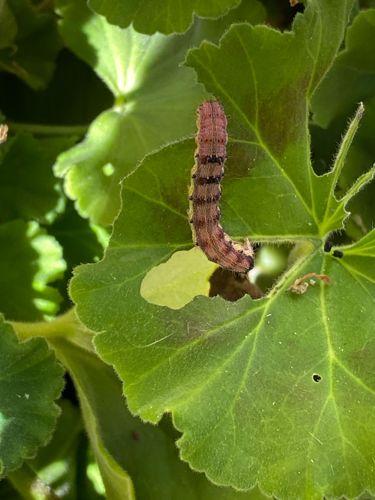Cabbage Looper (caterpillar stage)
Scientific Name: Trichoplusia ni
Order & Family: Lepidoptera, Noctuidae
Size: Larvae (caterpillar) typically grow to about 2.5-3.5 cm (1-1.5 inches) in length.

Natural Habitat
Agricultural fields, gardens, and greenhouses where host plants are present. They are especially prevalent in areas growing cabbage, broccoli, cauliflower, lettuce, and other brassicas. The specific plant in the image may be a geranium, which can also be a host.
Diet & Feeding
Herbivorous. Cabbage loopers feed on the leaves of a wide variety of plants, particularly cruciferous vegetables (cabbage, broccoli, kale), but also lettuce, tomatoes, potatoes, spinach, and some ornamental plants like geraniums. They chew irregular holes in leaves, often starting from the underside.
Behavior Patterns
Larvae move in a distinctive 'looping' motion, arching their bodies as they crawl due to having fewer prolegs in their middle segments. They are primarily nocturnal feeders but can be seen feeding during the day, especially when populations are high. They undergo complete metamorphosis, passing through egg, larval (caterpillar), pupal, and adult (moth) stages. The adult moth is nocturnal and lays eggs on the underside of leaves.
Risks & Benefits
Potential risks: Cabbage loopers are considered a significant agricultural pest. Their feeding can cause extensive damage to crops, leading to reduced yields and economic losses for farmers and gardeners. Potential benefits: In their adult moth stage, they can contribute to pollination, though their economic damage outweighs this benefit. They also serve as a food source for various predators and parasitoids, contributing to the food web.
Identified on: 10/5/2025